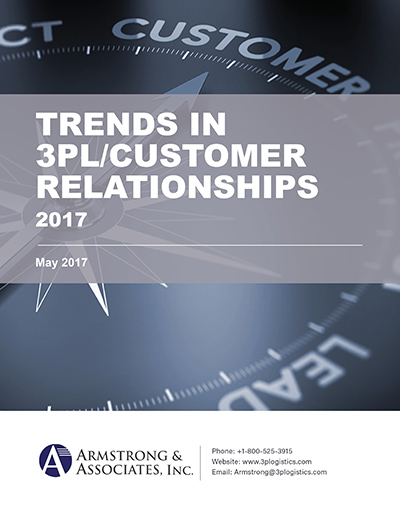Armstrong report points to continued increase in 3PL usage by shippers
A new report from supply chain consultancy Armstrong & Associates stated that 90% of Domestic Fortune 500 companies rely on third-party logistics (3PL) providers for outsourced logistics and supply chain services.
A new report from supply chain consultancy Armstrong & Associates stated that 90% of Domestic Fortune 500 companies rely on third-party logistics (3PL) providers for outsourced logistics and supply chain services.
Entitled “Trends in 3PL/Customer Relationships––2017,” this report serves as a follow-up to Armstrong’s 2013 edition, with the report quantifying major trends in 3PL customer relationships, with its findings based on analysis of more than 7,200 current 3PL customer relationships in 41 countries across almost 20,000 services.
Some of the report’s key findings include:
- Fortune 1,000 3PL revenues, which, at $132.8 billion, account for just under 80% of the U.S. 3PL market;
- 2016 3PL revenues for the Retailing and Technological industries came in at $32.4 billion and $30.6 billion, respectively; and
- Global Fortune 500 3PL revenues, at $273.8 billion in 2016, were paced by the Technological and Automotive industries, accounting for $77.2 billion and $52.5 billion, respectively
Global Fortune 500 3PL revenues, at $273.8 billion in 2016, were led by the Technological and Automotive industries, accounting for $77.2 billion and $52.5 billion, respectively, according to Armstrong, with the 2016 estimate up 6.5% compared to 2015 and up 27.8% going back to 2010. The firm also noted that Global Fortune 500 companies represent 37.2% of the $735.9 billion global 3PL market, which is broken down by Armstrong into various segments, including: Domestic transportation management, international transportation management, dedicate contract carriage, and value-added warehousing and distribution.
The report’s finding that 90% of Domestic Fortune 500 companies worked with at least one 3PL represents a significant increase from 2001’s 46%, which is when Armstrong first started tracking this data.
Armstrong explained that this increase reflects how shippers continue to outsource logistics functions to 3PLs “in order to control costs and increase supply chain efficiency,” and “company size continues to be a good predictor of 3PL use. The larger the company, the more likely it will have at least one relationship with a 3PL.” It also noted that larger companies use more 3PL services compared to smaller ones.
Armstrong & Associates Chairman Dick Armstrong said in an interview that one of the main takeaways from a shipper perspective when vetting a 3PL is to take a close look at what the 3PL’s technological capabilities are.
“Shippers need to focus on the technological capabilities of 3PLs and measuring its KPI’s in terms of how good the results are,” he said.
Addressing the rate of 3PL revenue growth over the years, according to industry, Dick Armstrong noted that the growth has been steady, as 3PLs have expanded their penetration of the market, which is expected to continue.
“We have more and more situations where the shippers, or the 3PL customers, are simply turning to 3PLs for solutions,” he said.
One area that has seen a significant amount of traction, he said, was with 3PL’s providing more services to e-commerce shippers in the B2C market, with 3PLs doing a very good job of multichannel servicing for things like e-fulfillment on a country-by-country basis, with the U.S. and Canada serving as one market.
Conversely, he said the brick and mortar stores “are in trouble all over the place, and that trend is just going to continue.
Looking at 3PL revenue expectations for 2017, Armstrong said it is reasonable to expect a single-digit increase in the range of 4-6%.













